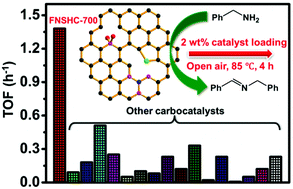Confined pyrolysis of a dye pollutant for two-dimensional F,N,S tri-doped nanocarbon as a high performance oxidative coupling reaction catalyst†
Abstract
Nanocarbon materials as metal-free catalysts for the oxidative coupling of primary amines to imines suffer from high catalyst loading, low reaction rate and high oxygen demand. Doping heteroatoms in nanocarbons is realized as an effective strategy to improve the catalytic activity, however, the doping of fluorine has been rarely studied. Here we synthesized a F,N,S tri-doped hierarchical nanocarbon (FNSHC) by pyrolyzing a fluorine-containing azo-sulphonate dye (acid red-337, a pollutant in wastewater) confined in a layered double hydroxide (LDH). The LDH-confined synthetic method is beneficial to the formation of a two-dimensional porous structure with a large specific surface area (∼1432 m2 g−1) and high fluorine content, enabling remarkable catalytic performance (98% yield in 4 h at 2 wt% catalyst loading under open-air conditions) and high recyclability, outcompeting current metal-free carbocatalysts. The conversion of environmental pollutants into heteroatom-doped carbon materials provides a new green strategy for the design and synthesis of functional carbon catalysts.



 Please wait while we load your content...
Please wait while we load your content...